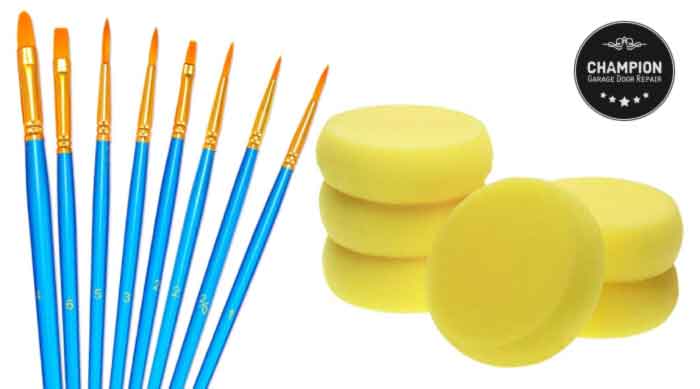Rust is created on metal garage doors through a chemical reaction known as oxidation. This reaction occurs when oxygen in the air combines with iron in the metal to form iron oxide, also known as rust. The presence of water or moisture on the door’s surface can accelerate the oxidation process, making it more likely for rust to form.
Additionally, living by the beach or in coastal areas can increase the risk of rust on your garage doors due to the high salt content in the air. Saltwater and salty air can corrode garage doors and accelerate the oxidation process, leading to rust formation. The salt in the air can also create a moist environment on the metal surface, which can speed up the rusting process.
There are several ways to remove rust from garage doors. Here are 4 methods that you can try:
1. Vinegar and baking soda: Mix equal parts of white vinegar and baking soda to form a paste. Apply the paste to the rusted surface and let it sit for at least 30 minutes. Scrub the surface with a brush or scouring pad, and then rinse with water.
2. Lemon and salt: Cut a lemon in half and sprinkle salt on the cut side. Rub the lemon over the rusted surface, squeezing out the juice as you go. Let it sit for a few hours, and then rinse with water.
3. Commercial rust removers: There are many rust removers available on the market, which you can find at hardware or home improvement stores. Follow the instructions on the product carefully.
4. Sandpaper or wire brush: If the rust is not too severe, you can try removing it by sanding or brushing it off with a wire brush. This method may require some elbow grease, but it can be effective.
Remember to wear gloves and protective eyewear when working with any of these methods. And always test a small, inconspicuous area first to make sure that the method you choose won’t damage the garage door.
Filling holes
Filling holes on a rusted garage door can be a challenging task, but it is possible with the right tools and techniques. If your rusted garage door has holes in it, here are some steps you can take to repair the damage:

Clean the area: Remove any loose rust and debris from the hole using a wire brush, sandpaper, or a grinder. This will help ensure that the filler adheres properly to the metal surface.
Apply rust converter: Use a rust converter to stop the rusting process and prevent it from spreading. Apply it according to the instructions on the product label and allow it to dry completely.
Dealing with large holes: If the hole is too large to be filled with just filler, you may need to cut a piece of sheet metal to fit over the hole. Use a pair of tin snips to cut the metal to the appropriate size and shape. Place the sheet metal over the hole and mark its edges with a marker. Then, use a grinder or sandpaper to rough up the area around the hole and the backside of the sheet metal for better adhesion.
Apply filler: You can use any filler for metal surfaces (even automotive body fillers). Mix the filler according to the instructions on the product label and apply it to the hole or the backside of the sheet metal. Use a plastic spreader to smooth out the filler and remove any excess.
Sand the surface: Once the filler is dry, use sandpaper to smooth out any rough edges or bumps.
Touching up steel painted garage doors
The process of removing rust will likely damage your garage door paint or finish. If your garage door is painted in white or any other standard color, it should be an easy fix. If your door is a faux wood garage door, touching it up would be a more complex process. Here are the steps you can follow:
Clean the surface: Use a clean cloth and a mild detergent solution to wipe down the area and remove any dust, debris, or remaining rust. Rinse with clean water and let it dry completely.
Apply primer (not mandatory): Apply a coat of primer to the affected area. Use a rust-inhibiting primer that is compatible with your topcoat. Follow the manufacturer’s instructions for application and drying time.
Sand the primer: Once the primer has dried, sand it lightly to create a smooth surface. Wipe the area with a clean cloth to remove any dust.
Apply touch-up paint: If you don’t have experience with painting, you may want to use a small paintbrush or sponge instead of a spray can to apply the touch-up paint to the affected area. Match the color and finish of the surrounding area as closely as possible. Apply the touch-up paint in thin, even coats, and let each coat dry completely before applying the next.

Use a light touch: Apply the paint in thin, even layers using a light touch. Too much pressure on the brush can leave brush marks on the surface.
Paint in one direction: Paint in one direction only, following the natural flow of the surface. This will help you to create a smooth, even finish.
Feather the edges: Feather the edges of the wet paint by lightly dragging the brush over the edges. This will blend the paint and create a seamless finish.
Work in small sections: Work in small sections to avoid the paint drying out before you can blend it. This will also help you to maintain a wet edge, making it easier to blend the paint.
Let the paint dry: Allow the touch-up paint to dry completely before using the surface. Follow the manufacturer’s instructions for drying time, which will typically be a few hours.
By following these steps, you can effectively touch up steel garage doors after removing rust, repair the damage and help prevent further rusting.
How to choose touch up paint for your garage door
Choosing the proper touch-up paint is important to ensure a good color match. Here are some factors to consider when selecting touch-up paint:
Match the color: The most important factor in choosing touch-up paint is to match the color of the existing paint. This can be done by checking the paint code of the original paint (consult the original installer) and finding a touch-up paint that matches it. If your garage door is a few years old and the paint is already faded, you may want to choose a softer tone.
Check the compatibility: Make sure that the touch-up paint is compatible with the type of paint on your surface. For example, if your surface is painted with an oil-based paint, make sure to use an oil-based touch-up paint.
Quality of the paint: The quality of the touch-up paint can also affect the final result. Look for high-quality touch-up paint that is designed to adhere to metal surfaces, resist fading, and provide a durable finish. If the surface is exposed to harsh weather conditions, extreme temperatures or chemicals, choose a touch-up paint that is formulated to withstand these conditions.
Test the touch-up paint: Before applying the touch-up paint on your garage door, test it on a small, inconspicuous area, to ensure that the color and finish match the surrounding area. The best approach is to paint a small piece of steel, which isn’t part of your garage door. Allow it to dray and then compare it to your garage door’s color.
By considering these factors, you can choose the proper touch-up paint that will provide a good color match and long-lasting results.
Final thoughts
Fixing rust on garage doors is an important maintenance task that can help extend the life of the door and improve its appearance. By using the aforementioned techniques, you can remove rust from any steel or metal surface (not only garage doors) and restore it to its original condition. If you’re not sure how to fix rust on your garage doors, consult a licensed garage door repair company before starting the process.







